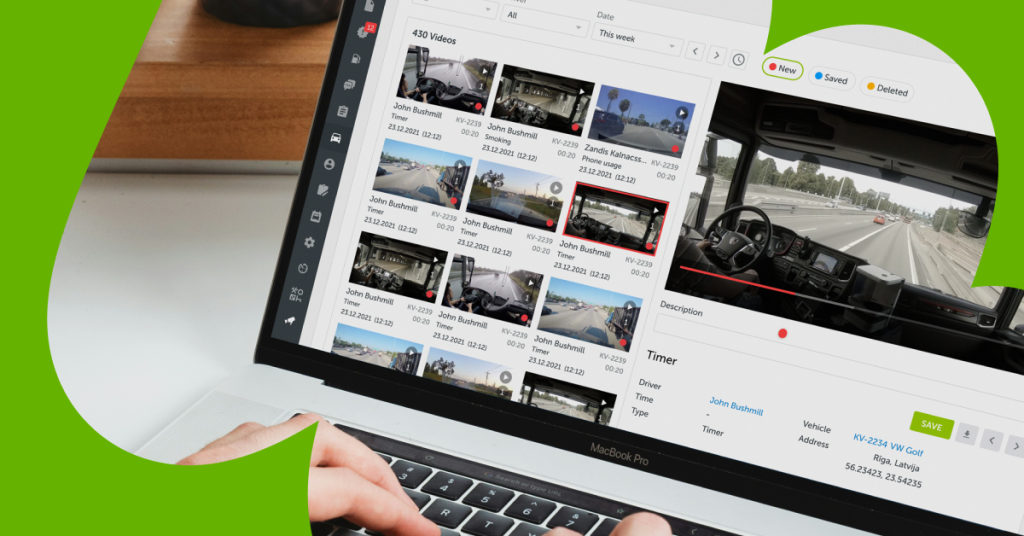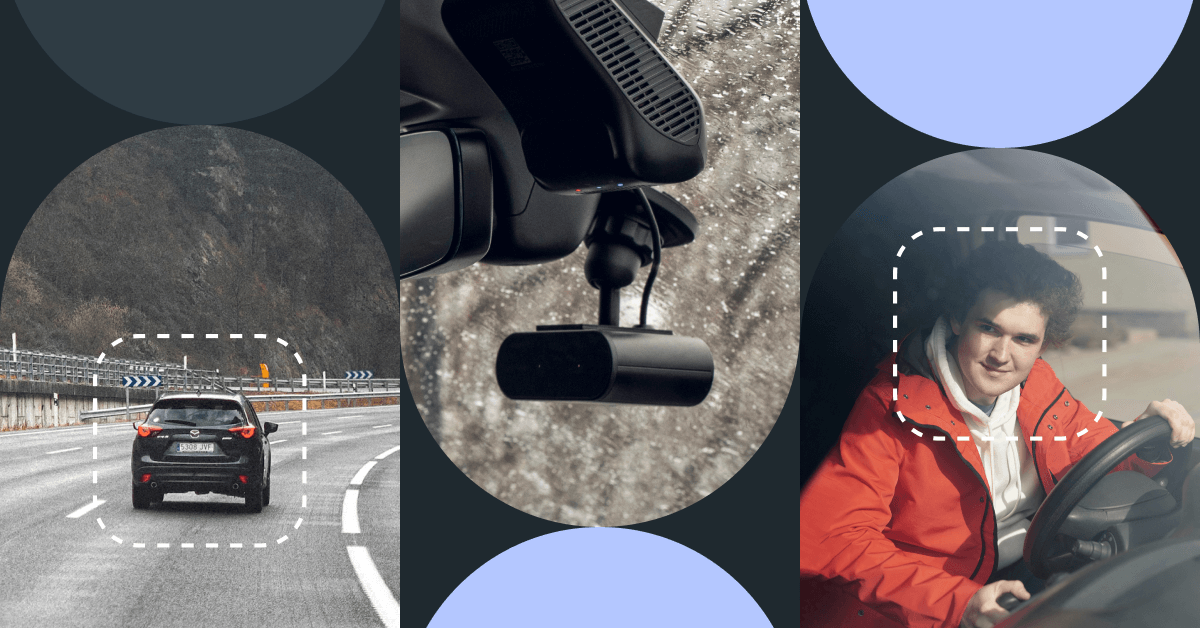A dash cam is a common thing in road vehicles these days. The main benefit is obvious – you get reliable footage to prove the accident wasn’t your fault.
You can easily purchase so-called consumer dash cams in most electronics shops and online retailers. However, fleet management companies like Mapon offer more advanced dash cams that we call fleet cameras. What’s the difference? Take a moment to compare a generic dash cam from a local shop to a business-grade fleet camera system.
| Feature | Fleet cameras | Consumer dash cams |
| Get footage in computer remotely | ||
| Get alerts when something goes wrong | ||
| Power source input | Directly from vehicle | Cigarette lighter |
| Automatic turn on and off | ||
| Attachment type | Screws or special adhesive | Suction cup |
| Amount of footage before overwrite | 48 – 72 hours | 12 – 24 hours |
| GPS tracking option | ||
| Visibility around the vehicle | Anywhere you need | Front of the vehicle |
1. Real reliability and security with a system
A generic dash cam is just that: a camera attached to the car’s dashboard or windshield. Mapon offers something more. Not only the camera itself, but a whole system called fleet management software. The camera has a SIM card, and it sends data to this platform using mobile data. This way, you can fix a lot of the problems that you would get with ordinary dash cams.
Remote access
Imagine your company’s vehicle got into a crash. Your driver knows it’s not their fault, but you need to double-check it and provide proof to the insurer and, in some cases, the court.
Since the vehicle is damaged, you need to drive to it to get the footage from the memory card. Then you need to get back to the office and load the file into the computer, and then upload it to provide access to relevant third parties. Can you imagine how much time and fuel this will take?
Compare the process to what would happen with a fleet camera system. The dash cam automatically detects that a crash occurred and uploads the relevant footage to the Mapon platform. It would take a couple of minutes at most, and there’s no need to physically visit the vehicle. Additionally, you can remotely access the memory card to get a larger piece of footage for more context.

Automatic notifications
When a crash happens, time is critical – to get help, of course, but also to prepare business arrangements, for example, to inform the client that the delivery will be late. Generic dash cams will help with none of that. But Mapon fleet cameras have multiple systems to inform you as soon as something happens:
- Get alerts in the platform or via SMS when the camera detects a crash
- Check the vehicle’s precise location on the map
- Use the camera’s live stream function to assess the situation
Then, it’s up to you to do what’s necessary in the specific situation: send a replacement vehicle, call an ambulance, inform the client, and so on. It’s easier and quicker to do when you have all the information you need.
2. Business-grade vs consumer-grade dash cams
Most commercial dash cams are by design made for consumer use, so they’re not as fit for fleets. There are multiple small, but very important ways how you will be inconvenienced when using a basic dash cam: manual power button, blocked cigarette lighter input, weaker type of attachment, smaller storage, and more. Let’s compare!
Better starting mechanism and power source
Any camera needs power to work, and most generic models use the cigarette lighter input (auxiliary power outlet if you want to sound fancy). It creates two big problems. First, it permanently occupies the cigarette lighter, so you’ll have no chance to charge your phone, for example. Or feel free to charge your phone and risk getting no accident footage.
Second, you’ll always need to manually turn on the camera. Sounds easy, but Murphy’s law says that an accident will happen that one time you forget to do it. You’ll also need to instruct employees to do it and hope they won’t use the excuse “forgot to turn it on” when they want to remove negative footage.
Fleet cameras are connected directly to the vehicle, fixing both problems. They don’t use the cigarette lighter, and will turn on automatically when the vehicle is started.
Stronger attachment and larger storage
Furthermore, simple dash cams are designed to be quickly attached to the windshield or dashboard with suction cups. They sacrifice sturdiness for speed. In case of an accident, it’s not uncommon for the camera to simply fall off due to the impact. This prevents it from filming the aftermath, and may damage the memory card, leaving you without any footage. In contrast, a fleet camera is attached using screws or a special adhesive, which is pretty hard to remove by accident.
One more issue concerns the memory card. To reduce the price, commercial dash cams have limited storage, in many cases 64 or 128 gigabytes (GB). In practical terms, this means up to 24h of footage at best. Around 3 workdays. When the storage is full, the oldest footage gets overwritten by new material. If you want to keep older footage, you need to load it regularly on a computer, and if you don’t do it, there’s no way to save that one important moment from 5 days ago.
Fleet camera systems have two solutions for this issue. First is simple – they have more storage, usually around 256GB. Second, fleet cams use sensors to detect important events and automatically upload the footage to the cloud, where it’s safe. Even if the memory card gets rewritten, the clip will still be available online on the fleet management platform. In it, you can also check the date of the oldest footage that’s still available in the memory card – and request a manual upload!
Smart extras you didn’t know about
Fleet cameras have some lovely features you will probably not find in a consumer dash cam:
- A button that lets the driver send footage to the cloud when something important happens
- A built-in GPS tracker that allows fleet managers to see the vehicle on a live map
3. There are more cams than just dash cams
For the sake of comparison, we’ve been only discussing dash cams. These are cameras that film the front of the vehicle. They are highly useful in many cases, but not always:
- What if an accident happened at the rear of the vehicle, or you need to monitor the cargo onloading / offloading?
- What if you wanted to cover blind spots in real-time?
- What if the driver needs to safely take care of business while the vehicle is still running?
A fleet camera system is great in that you can add eyes basically anywhere on your vehicle. Of course, some locations are more common than others: the dashboard, rear-view mirrors, the boot, and so on. If you add multiple cameras on one vehicle, you get a much more detailed view around it, making accident investigations, maneuvering (if a screen is installed in the cabin), and security management easier.
Needless to say, a generic dash cam can only be installed on a windshield or dashboard.
Surprising cost-efficiency
You might wonder how much all these benefits cost. With our full device rental model, you pay a fixed monthly fee that covers everything: the camera itself, mobile data, access to the fleet management platform, and even a replacement guarantee. So the upfront investment is not that big, unlike consumer dash cams that you would need to buy at full price or with large interest rates.
And the return on investment? Our clients report saving between €2,500 and €5,000 after a single accident by speeding up the investigation and proving the company’s driver was not at fault. That’s enough to cover the cost of installing cameras on 15 vehicles.
Contact us, and let’s protect your fleet’s future today!

